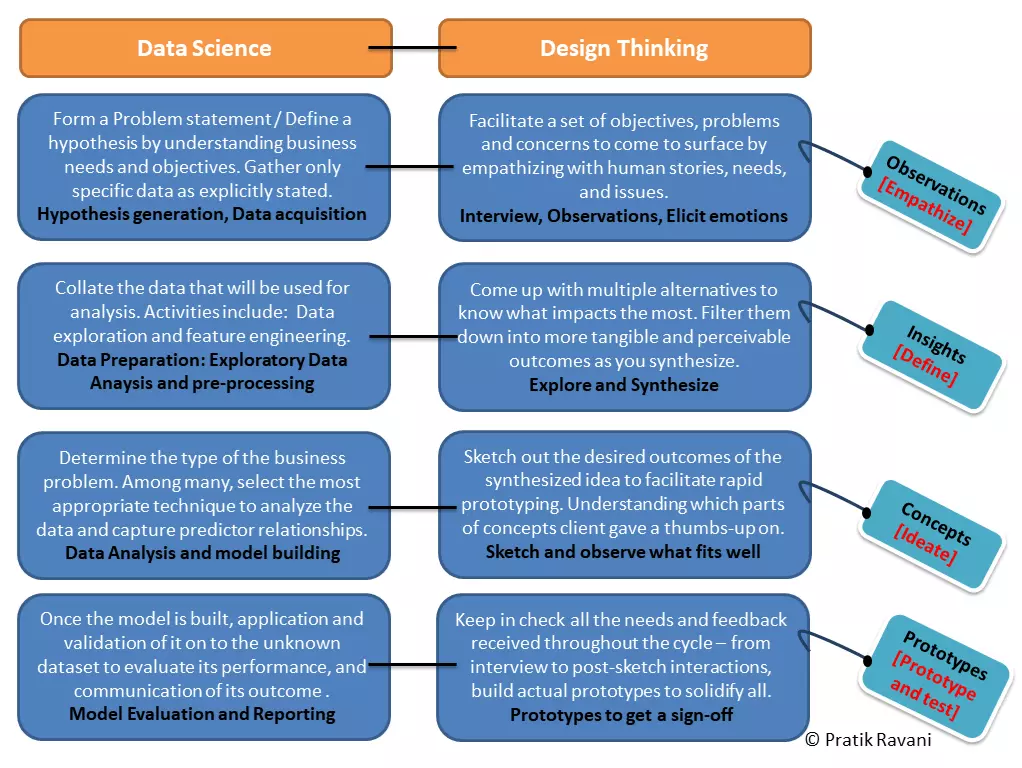Every data-servicing organization has now made peace with the fact that being able to manage its data well along with enabling its clients to manage their data well is a sure-fire path to gain a competitive advantage. So how do many data-talking organizations differ from those few data-driven ones? Why can’t they make a decisive cut?
To answer them, among many, I’d like to discuss one dimension which I have observed is the apparent reason for not faring well on various data projects. With it I would also highlight a parallel with Data Science – the domain which thankfully is in a very high demand but unfortunately is also the latest victim of lack of processes and standard guidelines, inadequate talent, and more importantly, unprepared mind sets.
Here I am proposing and introducing the Design Thinking process to strengthen and empower various data projects especially through the prism of Data Science.
In order to contextually understand, I bring in four quadrants of the cyclical version of Design Thinking from the designer Michael Barry, and humbly add a few dimensions from my own inferences of the subject in their explanations.
What Design Thinking entails:
- Observations: Take a deep dive of curiosity to listen to (not just hear) human stories behind business problems. Blend your observations of client behaviour, expressions, language with those spoken requirements and elaborated pinching issues. Finding data is easy, but the direction of finding data is often ignored. Here you would tap into those unspoken problem areas and jot them down like a doctor does to a patient based on hearing his symptoms. Here you would also need to establish a common terminology – in my words I call it a patient’s lingo. Being a doctor you would not throw around medical jargons. You would come down to his understanding and his choice of words to do his diagnosis.
- Insights: Having known the problem and gathering direction with appropriate data, there would be a time to generate multi-angled insights after synthesizing on all predictors - the EDA bit for those who know the game. Based on the prior step, the stories that stuck out the most and latent needs you discovered would be a foundation for your feature engineering to prepare the data for modelling. You may want to use Affinity diagrams to cluster your close findings with one another which would help you see the emerging pattern.
- Concepts: This is the stage of concretizing the best-looking option after trying out various possible ones and put it into a visual map. Allow your client to have a peek into your visualized solution. In Data Science, this is nothing but an overall architectural diagram with a data flow and showing as many nuts and bolts of the finer nuances as you can. For instance, sketching out a decision tree or a 2D graph with clusters populated. This purely depends on an individual how well he can convert his imagination into a sketch on paper or a graphical portrayal on a slide deck. This would help the client visualize before it is brought to life and you can get an expectation-check done yet again.
- Prototypes: This final stage is about actual doing. Once you get a buy-in from the client on your proposed visual outcome, here is where you need to give that drawing an actual form by infusing life into it. One of the most critical elements of prototyping is – speed. It is all about building a prototype and immediately cycle back to the square one - observations. Verify the actual versus the expected and get it validated. Here, I caution that you must avoid the temptation of drowning into perfection-attaining exercise in the first iteration. It would eat into crucial time you should otherwise have capitalized on to removing the fringes through testing.
Following image shows my analysis of how Data Science can be linked to and be strengthened by various stages of Design Thinking.

I recommend you to try out Design Thinking alongside your Data Science initiatives because of following reasons. Following bullet points are straight benefits of my proposal.
- Humane approach: Design Thinking as a methodology is specifically designed to pluck out human-oriented dimensions from the problem statement. As you know that when it comes to business, technical feasibility can be tackled and talents can be hired. The only thing that gets in the way of bagging business is – connecting with and convincing the one who could buy into our capability and put money on the table. Especially in today’s age when domains like Data Science and AI which are sufferers of half-baked understanding, you need nothing more than presenting problem-solver’s mind set. The very first step of Design Thinking – Empathize - is targeted to ensure that you put your first foot in the right direction.
- Common Language: As you might have experienced that communication is such an art that can make or break long-held learnings and preconceived notions. It is always about the ear of a hearer and not the tongue of the teller that counts, if I recall Shakespeare’s still-valid warning. Those frequently uttered algorithms, techniques, tools, promises of AI world have many jargons and even more interpretations. Design process thankfully promotes a common terminology which should be known to and accepted by all stakeholders. This reduces the chance of your prospect imagining you with a magic wand and a sorcerer’s hat when you explain the case of predictive analytics.
- Quicker course correction: However much understanding your client has developed, on a normal day, he may want a jet-speed project delivery with a shoestring budget (assuming he okays for a paid Proof-of-Concept). Launching yourself along with your team for over a couple of weeks/months to develop based on a loose discussion, and still running a risk of your client finding it off the mark in the end, is disheartening. Thankfully the Design Thinking approach encourages fast-fail possibility through its quick prototyping which gives you sooner feedback and keeps you anchored and enthused with what is required.
- Continual improvement: Both Design Thinking and Data Science are iterative processes, and if employed how they should be, they demand a tight connect with your organizational culture. If yours is a data-leaning organization and is ready to imbibe what I call a Data culture, then constant refreshing through iteration is a non-negotiable step. Mind you, this replicable approach needs skilled, well-meaning, and forward-looking practitioners who believe that data and design are organizational properties, not of those individuals’ who are their custodians.
In a Nutshell
The reason I vouch for Design Thinking is because it respects time, talent, and goals of organizations. Most companies go the wrong route either by unwittingly sharing faulty requirements or by mistakenly assuming something that shouldn’t be assumed. The adoption would let you pick up a project or an assignment only when it is an absolute win-win both for you and for your client. It introduces a structure in the sphere of ambiguity. It ensures that there is no room for misinterpretation or misunderstanding in expressing intent or communicating results.
I strongly believe that if you are into services business, and you earn your bread and butter and jam and cheese through services only then remember this: Servicing your client without extending empathy is only a temporary transaction and not a long-lasting relationship of mutual growth. Embrace design methodology to insulate your downside risk of service delivery in this fast-moving fourth industrial revolution.




Leave your comments
Post comment as a guest